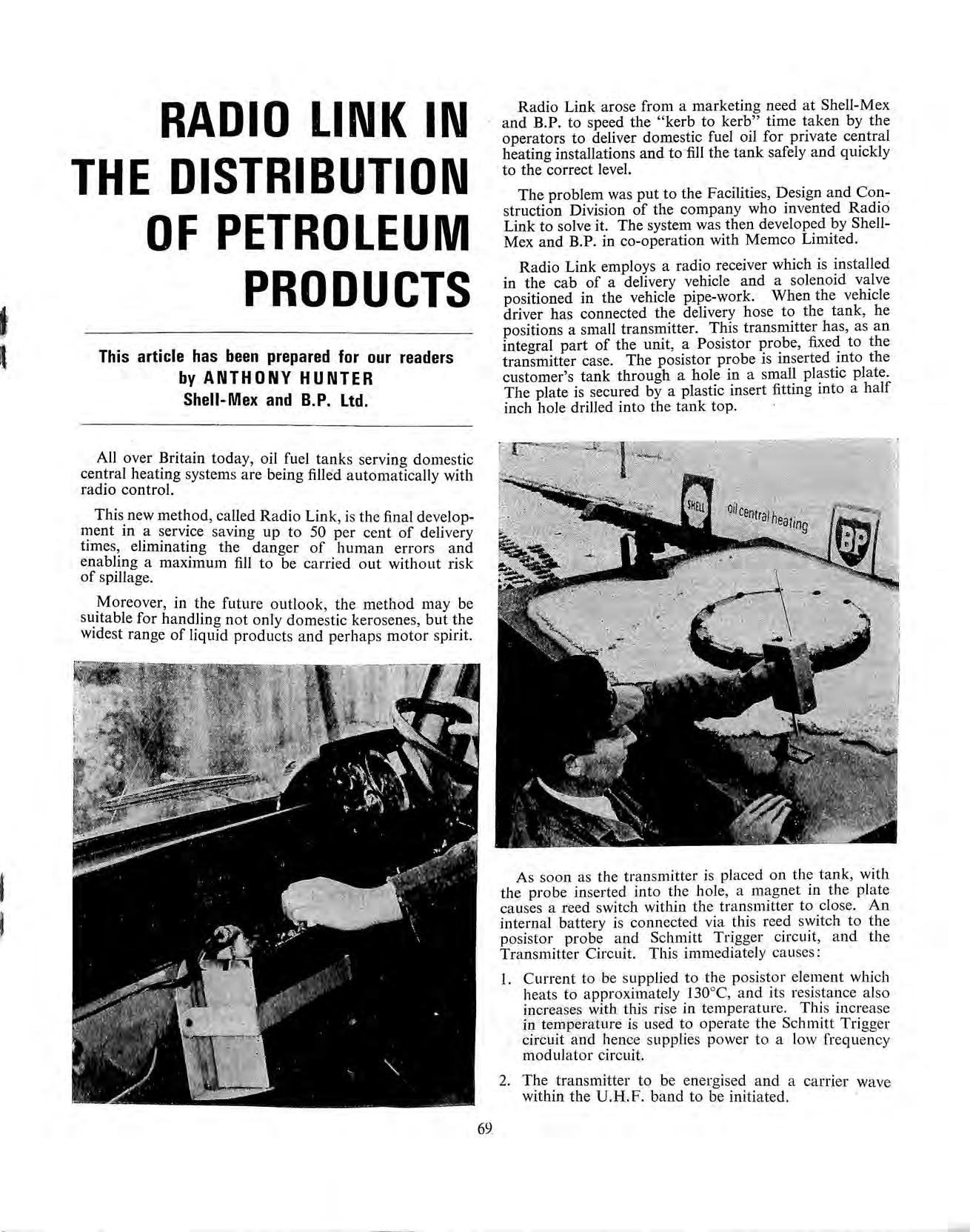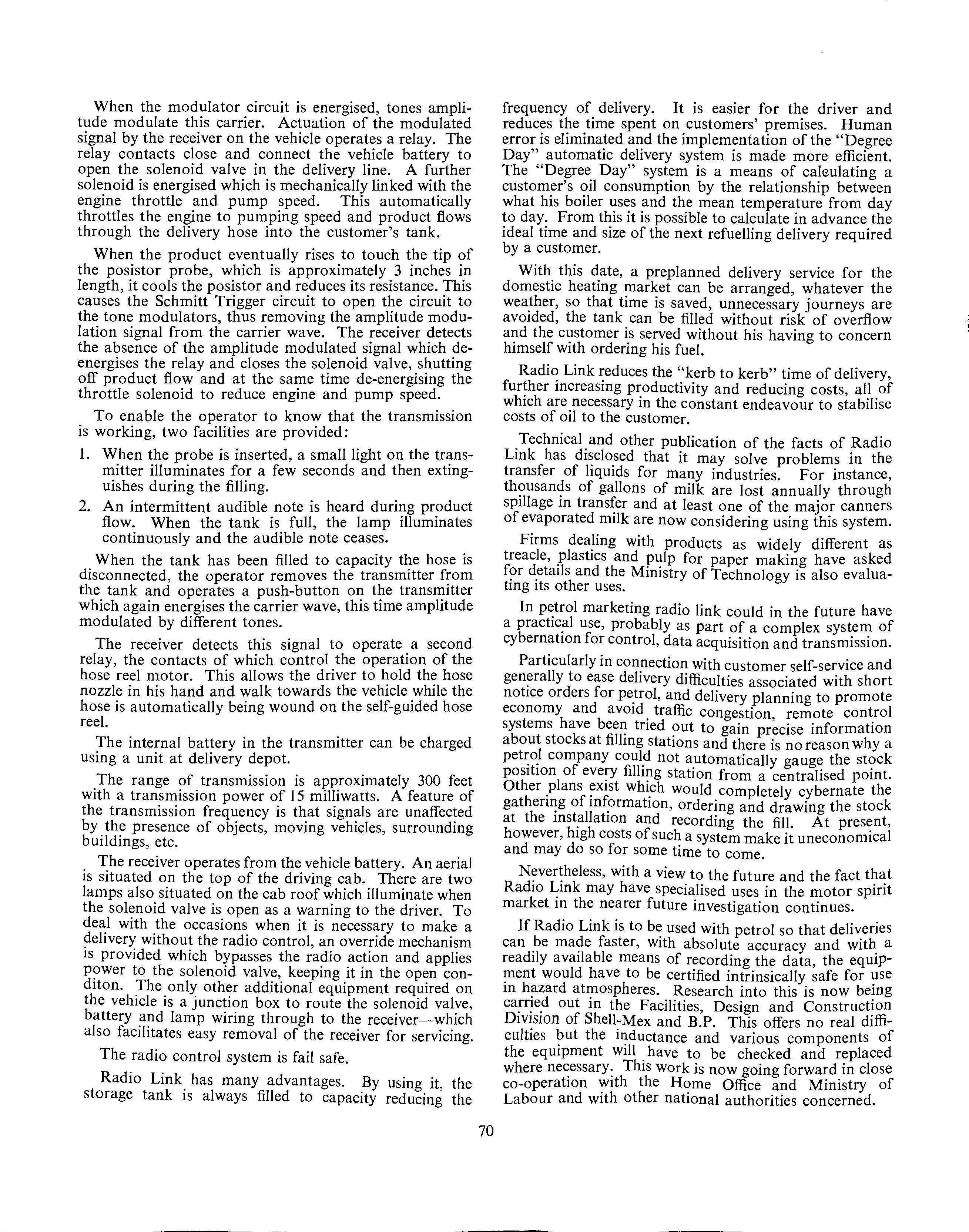
7 minute read
RADIO LINK IN THE DISTRIBUTION OF PETROLEUM PRODUCTS-ANTHONY HUNTER
by apeauk
RADIO LINK IN THE DISTRIBUTION OF PETROLEUM PRODUCTS
This article has been prepared for our readers by ANT H 0 NY H U NT ER Shell-Mex and B.P. Ltd.
Advertisement
All over -!3ritain today, oil _fuel tanks serving domestic cen!ral heatmg systems are bemg filled automatically with radio control. This. new met~od, cal_led Radio Link, is the final development m a service savmg up to 50 per cent of delivery times~ eliminati_ng the danger of human errors and enabl_mg a maximum fill to be carried out without risk of spillage. _Moreover, in t~e future outlook, the method may be s~1table for handlmg not only domestic kerosenes, but the widest range of liquid products and perhaps motor spirit. Radio Link arose from a marketing and B.P. to speed the "kerb to kerb" need time at Shell-Mex taken by the operators to deliver domestic heating installations and to fill fuel oil for private central the tank safely and quickly to the correct level. The problem was put to the Facilities, Design and Construction Division of the company who invented Radio Link to solve it. The system was then developed by ShellMex and B.P. in co-operation with Memco Limited. Radio Link employs a radio receiver which is installed in the cab of a delivery vehicle and a solenoid valve positioned in the vehicle pipe-work. When the vehicle driver has connected the delivery hose to the tank, he positions a small transmitter. This transmitter has, as an integral part of the unit, a Posistor probe, fixed to the transmitter case. The posistor probe is inserted into the customer's tank through a hole in a small plastic plate. The plate is secured by a plastic insert fitting into a half inch hole drilled into the tank top.
As soon as the transmitter is placed on the tank, with the probe inserted into the hole, a magnet in the plate causes a reed switch within the transmitter to close. An internal battery is connected via this reed switch to the posistor probe and Schmitt Trigger circuit, and the Transmitter Circuit. This immedfately causes: I. Current to be supplied to the posistor element which heats to approximately 130°C, and its resistance also increases with this rise in temperature. This increase i1~ te1:11perature is used t _ o operate the Schmitt Trigger circtut and hence supplies power to a low frequency modulator circuit. 2. The transmitter to be energised and a carrier wave within the U.H.F. band to be initiated.
69
When the modulator circuit is energised, tones amplitude modulate this carrier. Actuation of the modulated signal by the receiver on the vehicle operates a relay. The relay contacts close and connect the vehicle battery to open the solenoid valve in the delivery line. A further solenoid is energised which is mechanically linked with the engine throttle and pump speed. This automatically throttles the engine to pumping speed and product flows through the delivery hose into the customer's tank.
When the product eventually rises to touch the tip of the posistor probe, which is approximately 3 inches in length, it cools the posistor and reduces its resistance. This causes the Schmitt Trigger circuit to open the circuit to the tone modulators, thus removing the amplitude modulation signal from the carrier wave. The receiver detects the absence of the amplitude modulated signal which deenergises the relay and closes the solenoid valve, shutting off product flow and at the same time de-energising the throttle solenoid to reduce engine and pump speed.
To enable the operator to know that the transmission is working, two facilities are provided: I. When the probe is inserted, a small light on the transmitter illuminates for a few seconds and then extinguishes during the filling. 2. An intermittent audible note is heard during product flow. When the tank is full, the lamp illuminates continuously and the audible note ceases.
When the tank has been filled to capacity the hose is disconnected, the operator removes the transmitter f~om the tank and operates a push-button on the transmitter which again energises the carrier wave, this time amplitude modulated by different tones.
The receiver detects this signal to operate a second relay, the contacts of which control the operation of the hose reel motor. This allows the driver to hold the hose nozzle in his hand and walk towards the vehicle while the hose is automatically being wound on the self-guided hose reel.
The internal battery in the transmitter can be charged using a unit at delivery depot.
The range of transmission is approximately 300 feet with a transmission power of 15 milliwatts. A feature of the transmission frequency is that signals are unaffected by the presence of objects, moving vehicles, surrounding buildings, etc.
The receiver operates from the vehicle battery. An aerial is situated on the top of the driving cab. There are two lamps also situated on the cab roof which illuminate when the solenoid valve is open as a warning to the driver. To deal with the occasions when it is necessary to make a delivery without the radio control, an override mechanism is provided which bypasses the radio action and applies P?Wer to the solenoid valve, keeping it in the open cond1ton. The only other additional equipment required on the vehicle is a junction box to route the solenoid valve, battery and lamp wiring through to the receiver-which also facilitates easy removal of the receiver for servicing.
The radio control system is fail safe.
Radio Link_ has many advantages. By using it, the storage tank is always filled to capacity reducing the frequency of delivery. It is easier for the driver and reduces the time spent on customers' premises. Human error is eliminated and the implementation of the "Degree Day" automatic delivery system is made more efficient. The "Degree Day" system is a means of caleulating a customer's oil consumption by the relationship between what his boiler uses and the mean temperature from day to day. From this it is possible to calculate in advance the ideal time and size of the next refuelling delivery required by a customer.
With this date, a preplanned delivery service for the domestic heating market can be arranged, whatever the weather, so that time is saved, unnecessary journeys are avoided, the tank can be filled without risk of overflow and the customer is served without his having to concern himself with ordering his fuel.
Radio Link reduces the "kerb to kerb" time of delivery, further increasing productivity and reducing costs, all of which are necessary in the constant endeavour to stabilise costs of oil to the customer.
Technical and other publication of the facts of Radio Link has di~clo_sed that it may solve problems in the transfer of hqmds for many industries. For instance, th~msan~s of gallons of milk are lost annually through spillage m trans~er and at least one of the major canners of evaporated mlik are now considering using this system.
Firms dea!ing with products as widely different as treacle, plastics and pi:lp for paper making have asked f?r d.eta1ls and the Mm1stry of Technology is also evaluatmg its other uses.
In petrol marketing radio link could in the future have a practic~l use, probably as part of a complex system of cybernat10n for control, data acquisition and transmission.
Particularly in connection with customer self-service and gen~rally to ease delivery difficulties associated with short notice orders for pe_trol, and delivery planning to promote economy and avoid. traffic congestion, remote control systems have beel! tned ?ut to gain precise information about stocks at fillmg stat10ns and there is no reason why a pet~o.l company coul.d not automatically gauge the stock pos1t10n of every fillmg station from a centralised point. Other plans ~xist whi_ch would completely cybernate the gathenl!g of m~ormat10n, ordering and drawing the stock at the mst_allat10n and recording the fill. At present, however, high costs of such a system make it uneconomical and may do so for some time to come.
Nevertheless, with a view to the future and the fact that Radio Link may have specialised uses in the motor spirit market in the nearer future investigation continues.
If Radio Link is to be used with petrol so that deliveries can ?e ma?e faster, with absolute accuracy and with. a readily available means of recording the data, the equ1p~ent would have to be certified intrinsically safe for :ise m hazard atmospheres. Research into this is now bemg ca:r~e.d out in the Facilities, Design and Construction DlVISJOil of Shell-Mex and B.P. This offers no real difficulties but the inductance and various components of the equipment will have to be checked and replaced where ne~essary: This work is now going forward in close co-operat10n with the Home Office and Ministry of Labour and with other national authorities concerned.

70










